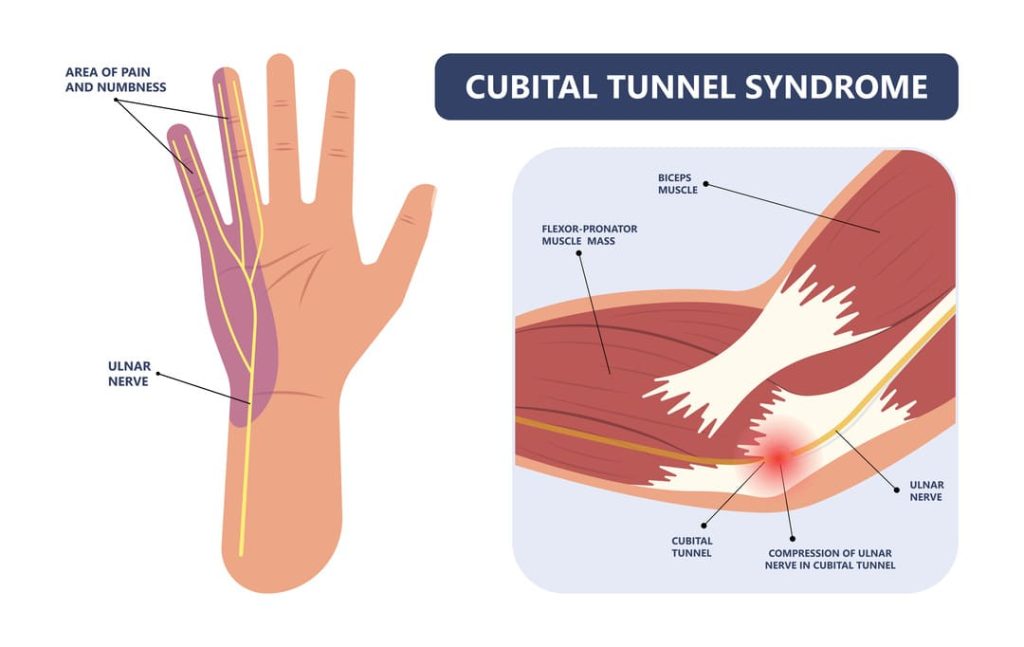Looking for Expert-Level VA Claim Answers?📱Call Us Now! 737-295-2226
What cubital tunnel syndrome VA rating do you deserve? We’re going to find out!
Cubital tunnel syndrome causes numbness and tingling in your pinky and ring fingers, making them difficult to straighten.
In this post, I’ll answer top questions regarding obtaining a cubital tunnel syndrome VA rating, ensuring you receive the VA disability benefits and compensation you deserve.
Table of Contents
Summary of Key Points
-
The VA rates cubital tunnel syndrome under diagnostic codes 8516, 8616, and 8716.
-
Your cubital tunnel syndrome VA rating will depend on the severity of your condition, including your range of movement.
-
It’s common for cubital tunnel syndrome to lead to secondary conditions, including depression and anxiety.

What is Cubital Tunnel Syndrome?
According to the Cleveland Clinic, cubital tunnel syndrome occurs when the ulnar nerve is irritated or compressed inside the elbow.
Cubital tunnel syndrome is also referred to as ulnar nerve entrapment.
Unfortunately, a compressed ulnar can lead to uncomfortable symptoms and, if left untreated, can cause muscle weakness.
As a veteran, you may be entitled to a cubital tunnel syndrome VA rating if you can prove your military service caused your condition.
What Causes Cubital Tunnel Syndrome in Veterans?

Military service can put your body through a lot of strain and stress. So, it’s no surprise if you return with aches and pains that weren’t there when you started. (Aches and pains are truly an understatement!)
It’s common for veterans to develop cubital tunnel syndrome due to the constant stress they put on themselves daily, potentially qualifying them for ulnar nerve VA disability.
A 2019 study found that U.S. Army service members have a significantly higher risk of developing cubital tunnel syndrome.
Risk factors for cubital tunnel syndrome include:
- Traumatic injuries
- Throwing things over your head
- Bending your elbow for extended periods of time
- Resting your elbows on hard surfaces
- Repetitive motion injuries
In addition, if you have a service-connected diagnosis of diabetes, you may be at greater risk for developing cubital tunnel syndrome.
What’s the Difference Between Cubital Tunnel and Carpal Tunnel?
Simply put, cubital tunnel affects your pinky and ring finger, while carpal tunnel affects your thumb, index finger, and middle finger.
If you’re unsure what condition you may have, it’s best to make an appointment with an orthopedic physician, who can help determine if you may qualify for an ulnar nerve entrapment VA rating.
Looking for more information about carpal tunnel? Check out our ultimate guide about the VA rating for carpal tunnel.
VA Rating for Cubital Tunnel Syndrome
Cubital Tunnel VA ratings are 10%, 20%, 30%, 40%, 50%, and 60%. You can find the cubital tunnel syndrome VA ratings under diagnostic codes 8516, 8616, and 8716, paralysis of the ulnar nerve.
Your VA rating for cubital tunnel syndrome will depend on the severity of symptoms and how much you can move your wrist, thumb, and fingers.
Cubital Tunnel VA Rating Chart
| Paralysis of: | VA Rating % | |
| Major | Minor | |
| Complete; the “griffin claw” deformity, due to flexor contraction of ring and little fingers, atrophy very marked in dorsal interspace and thenar and hypothenar eminences; loss of extension of ring and little fingers cannot spread the fingers (or reverse), cannot adduct the thumb; flexion of wrist weakened | 60% | 50% |
| Incomplete: | ||
| Severe | 40% | 30% |
| Moderate | 30% | 20% |
| Mild | 10% | 10% |
Diagnosing Cubital Tunnel Syndrome
You must have an official medical diagnosis before filing a VA claim for cubital tunnel syndrome.
The following are ways your healthcare provider may better assess your condition to determine an official diagnosis:
- Nerve conduction
- Electromyogram (EMG)
- x-Rays
In addition, your doctor will ask how long you’ve been experiencing your symptoms to begin the diagnosis process.
How to Service-Connect Cubital Tunnel Syndrome
To get a cubital tunnel VA rating, you need to service connect your condition. If you have your medical diagnosis of cubital tunnel syndrome, you’ve already completed step one of service-connecting your condition.
Let’s look at the three things you need to service-connect cubital tunnel syndrome.
- A current medical diagnosis of cubital tunnel syndrome
- Proof of an in-service event, injury, illness, or aggravation
- A medical link, or nexus, between your cubital tunnel syndrome and your military service
You can begin filing a VA claim once these three are lined up.
What’s the Fastest Way to File a VA Claim for Cubital Tunnel?
To get a VA rating for cubital tunnel syndrome, you need to file a VA claim. Generally, the fastest way to file a VA claim for cubital tunnel is online. However, I understand that method isn’t for everyone. The good news is that you have other options.
You can apply for VA disability in the following ways:
- Mail to:
Department of Veterans Affairs
Claims Intake Center
PO Box 4444
Janesville, WI 53547-4444
- Fax:
If you’re in the U.S., fax your application to 844-531-7818.
If you’re outside the U.S., fax your application to 248-524-4260.
- In person at your closest VA regional office
Secondary Conditions to Cubital Tunnel Syndrome
It’s common for veterans with cubital tunnel syndrome to develop secondary conditions, including mental health disorders and arthritis, although not every veteran with the condition will experience these secondary conditions.
For example, research shows that patients with cubital tunnel syndrome are at greater risk of developing anxiety and depression. It’s recommended that patients with cubital tunnel syndrome be screened for anxiety and depression to help with early detection.
Check out our guide, What are VA Secondary Conditions? for more information!
What is the Bilateral Factor for Cubital Tunnel Syndrome?
If your condition affects both sides of your body, you may qualify for the bilateral factor for cubital tunnel syndrome.
If eligible, you’ll receive a 10% addition to your service-connected VA rating before continuing with further combinations or converting to the degree of disability.
The bilateral factor applies if you have disabilities affecting your left and right lower extremities or the left and right upper extremities.
RELATED: The VA Bilateral Factor
About VA Claims Insider

- VA Claims Insider is the #1 most trusted name in VA disability claims.
- Work directly with a VA claims coach who can educate you to VA claim victory.
- 25,000+ disabled veterans have served in our membership programs since 2016.
- 30% average rating increase for veterans who complete our #1-rated Elite program.
- 4.7/5.0 average rating out of 5,500+ total reviews; over 4,500 5-star reviews.
Author

Kelly Olone
Kelly Olone is a military spouse who earned her degree in Psychology from Florida International University. After working in the non-profit sector for several years, she turned to her passion for writing. She aims to contribute to a better understanding of the valuable benefits that veterans deserve. As a mom, Kelly navigates the delicate balance between deadlines and bedtime stories with finesse.


